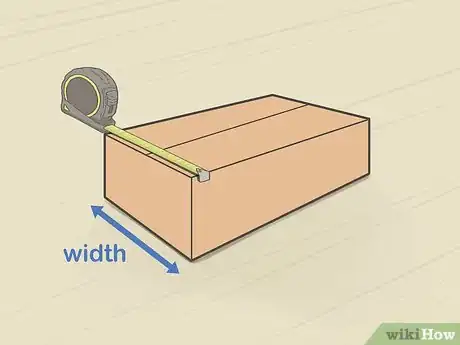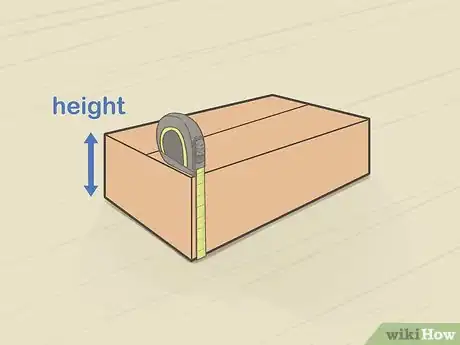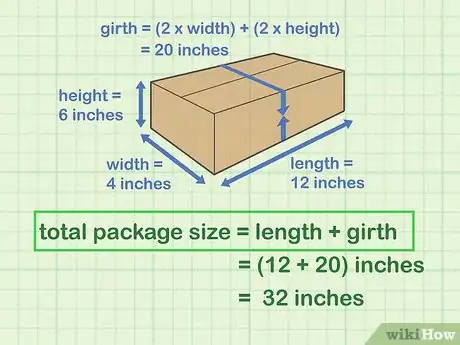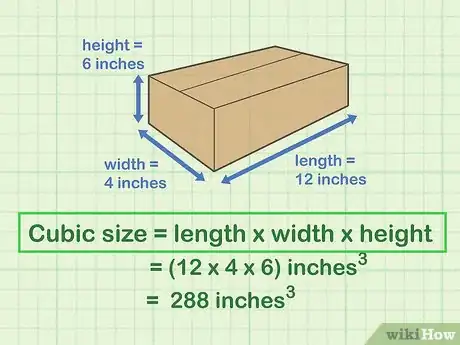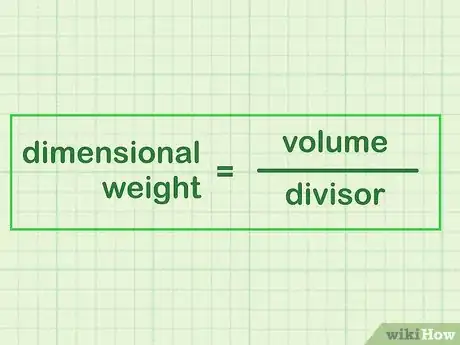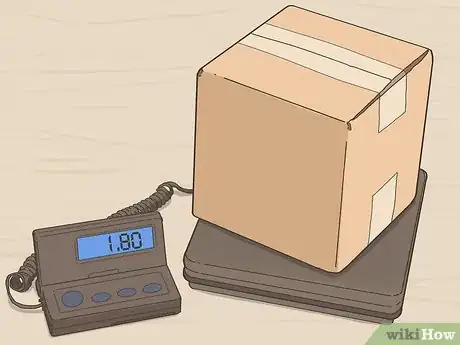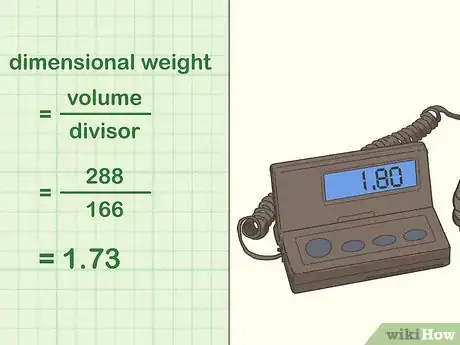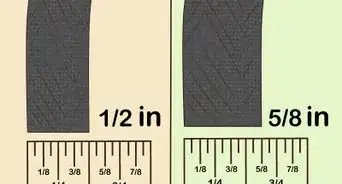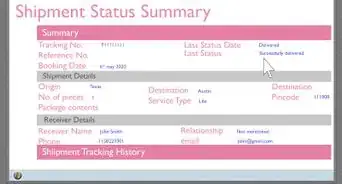This article was co-authored by wikiHow Staff. Our trained team of editors and researchers validate articles for accuracy and comprehensiveness. wikiHow's Content Management Team carefully monitors the work from our editorial staff to ensure that each article is backed by trusted research and meets our high quality standards.
There are 11 references cited in this article, which can be found at the bottom of the page.
This article has been viewed 655,720 times.
Learn more...
Regardless of which service you choose, the cost associated with shipping a package will vary depending on its size. In order to make sure you’re paying the right amount for shipping, it’s important to know the exact dimensions of the box you’re sending your item in. Use a dependable measuring tool to find the length, width, and height of the box. You can then use these measurements to calculate other metrics like total size and dimensional weight, which might contribute to the package’s billable weight.
Steps
Taking the Dimensions of an Ordinary Package
-
1Measure the longest side of the package. Start by identifying the longest side of the package, then hold a ruler or tape measure up to the edge and determine the total length from one end to the other. Round your measurement off to the nearest 1 in (2.5 cm).[1]
- Be sure to jot down the measurements you take on a scrap piece of paper so you can refer back to them later.
- The length will be the largest measurement on the majority of packages.
- Many shipping serves only handle packages of up to a certain size, which is typically noted in whole inches.
-
2Turn your measuring tool 90 degrees to find the width. The width is the distance from one “wall” of the shortest side of the box to the opposite wall. Stretch your ruler or tape across the package from edge-to-edge, then round to the nearest full inch.[2]
- You have more margin of error here than you do with the length, as your width and height measurements don’t need to be totally accurate. Even if they’re a little off, it shouldn’t affect the final calculation.
Advertisement -
3Hold your measuring tool vertically to record the height. Measure the standing side of the box from bottom to top, or vice versa. Round the box’s height dimension to the closest inch, the same way you did with your previous measurements.[3]
- On regular slotted cartons (RSCs), the most common type of shipping box, both horizontal surfaces are identical, meaning either end could be used as the top or bottom.[4]
- With most packages, the height is often the smallest individual measurement.
Tip: If your package has an irregular shape, treat it the same way you would a normal rectangular package, taking the length, width, and height from each of the box’s extreme points.
-
4Double the width and height and add them together to find the package’s girth. Look back over the measurements you wrote down earlier and multiply the width and height dimensions by 2. Then, add the doubled width and doubled height together. The number you get will be the estimated girth of the box.[5]
- If your box is 12 inches (30 cm) long, 4 inches (10 cm) wide, and 6 inches (15 cm) tall, doubling the width and height would give you 8 inches (20 cm) and 12 inches (30 cm), or 20 inches (51 cm) altogether.
- The term “girth” refers to the total distance around the thickest part of the box.[6]
- Don’t factor in the length measurement. The girth measurement only applies to the area encircling the shortest side of the package.
-
5Calculate the combined length and girth to get your total package size. Sometimes when shipping ground packages, you might be asked to provide the overall size of the package. To do this, simply add the length and girth measurements together. You’ll then have a single number to describe the approximate size of your package, which will be helpful when it comes time to load it up and send it off.
- Adding 12 inches (30 cm) of length to the measurements in the previous example, you’d get a total girth of 32 inches (81 cm).
- If the package you’re shipping is larger than 130 inches (330 cm), you may be charged an additional special handling fee. Most shipping services won’t accept packages larger than 165 inches (420 cm).[7]
Calculating Dimensional Weight
-
1Measure the length, width, and height of your package. Use a ruler or tape measure to find the dimensions of the package’s longest side, shortest side, and standing sides. Round each of your measurements off to the nearest whole inch and write them down on a piece of paper.
- When calculating the dimensional weight of a package, it doesn't matter which measurement corresponds to which side—all that matters is that all of your measurements are as accurate as possible.[8]
- Note that dimensional weight calculations can only be used with imperial units of measurement. They will not work for metric measurements. (To use the formulas below with the metric system, replace 166 with 5000.)
-
2Multiply the length, width, and height of the box to calculate its cubic size. Cubic size is essentially the same thing as volume, which indicates the amount of space inside the box. If you have a package with a length of 12 inches (30 cm), a width of 8 inches (20 cm), and a height of 4 inches (10 cm), it’s total cubic size would be 384 inches (980 cm).[9]
- Some shipping services may use the term “volume” in place of “cubic size.”
-
3Divide the cubic size by the appropriate divisor to get the dimensional weight. Shipping costs differ based not only on a package’s size, but its destination. For shipments being sent within the U.S or Puerto Rico, divide the cubic size of your package by 166. For international shipments, divide the cubic size by 139.[10]
- Going off the cubic size calculated in the previous example, the dimensional weight would be 2.31 for domestic handling and 2.76 for international shipments.[11]
- Don’t round your dimensional weight. It needs to be exact in order to properly tab up your shipping costs.
-
4Weigh your package on a postage scale to determine its actual weight. Place your package on the scale and wait for it to display a reading. Be sure to record the weight accurately, as you’ll be checking it against the package’s dimensional weight to see how much you can expect to pay for shipping.[12]
- You can request to have your package measured at the post office if you don’t own a postage scale.
Tip: Having your own postage scale can save you valuable time and energy if you’re a frequent shipper. It’s possible to buy a good postage scale online for as little as $20-30.
-
5Compare your package’s actual weight to its dimensional weight. If the dimensional weight is greater than the actual weight, it will be designated as the “billable weight,” or the weight you’re being charged to ship. Most shipping services set the larger of the two measurements as the billable weight in order to maximize their profits per shipment.[13]
- It’s important to know the actual weight of your package as well as it’s dimensional weight, as dimensional weight is only an estimate, not a precise measurement.
- Under ordinary circumstances, shipping costs are based on a package’s dimensional weight, which is a function of its length, width, and height. Abnormally heavy packages, however, are often priced by their actual weight to reflect the added size.[14]
Community Q&A
-
QuestionHow do I calculate the volume of an object whose dimensions are L=320, b=160, and h=110?
 Community AnswerMultiply the length by the base (or width) by the height.
Community AnswerMultiply the length by the base (or width) by the height. -
QuestionHow do I find the length, breadth and height of a tank?
 Community AnswerHeight is the ground to the top, length is the diameter and breadth is the distance around the tank.
Community AnswerHeight is the ground to the top, length is the diameter and breadth is the distance around the tank. -
QuestionHow do I know what size shipping box I need?
 Community AnswerMeasure the item length, width and height of the item you wish to ship. Find a box that is large enough to fit the object in.
Community AnswerMeasure the item length, width and height of the item you wish to ship. Find a box that is large enough to fit the object in.
Things You'll Need
- Ruler or tape measure
- Postage scale (optional)
References
- ↑ https://www.scientificamerican.com/article/bring-science-home-juice-box-geometry/
- ↑ https://www.scientificamerican.com/article/bring-science-home-juice-box-geometry/
- ↑ https://www.scientificamerican.com/article/bring-science-home-juice-box-geometry/
- ↑ http://www.argrov.com/cgi-bin/about_boxes.cgi
- ↑ https://www.usu.edu/math/koebbe/online_math_1100/lesson_examples/section3.4/problem33.pdf
- ↑ https://bizfluent.com/how-8237197-calculate-girth-usps.html
- ↑ https://bizfluent.com/how-8237197-calculate-girth-usps.html
- ↑ https://www.efulfillmentservice.com/2014/09/new-fedex-ups-dimensional-weight-rules/
- ↑ https://www.bbc.com/bitesize/articles/z3jrxfr
- ↑ http://images.fedex.com/us/services/pdf/packaging/GrlPkgGuidelines_fxcom.pdf
- ↑ https://www.efulfillmentservice.com/2012/11/how-to-calculate-dimensional-weight/
- ↑ https://www.usps.com/business/verify-postage.htm
- ↑ http://www.fedex.com/in/tools/dimweight.html
- ↑ https://www.flagshipcompany.com/blog/shipping-tips/actual-weight-vs-dimensional-weight-and-the-relation-to-billable-weight-1284/
About This Article
To measure the dimensions of a shipping box, start by measuring one of the long sides of the package from one end to the other with a measuring tape, measuring stick, or ruler. This measurement will be the length. Write down the number so that you don’t forget. Next, turn your measuring tool 90 degrees and measure along one of the short sides of the package to find the width. Finally, hold the tool vertically and measure from the top of the box to the bottom to find the height. If you need to find the girth of the package, multiply the width and the height times 2 and add both of the resulting numbers together. For instance, if your package is 6 inches (15 cm) high and 4 inches (10 cm) wide, the girth would be 20 inches (51 cm). Add the length to the girth to get the total package size. For instance, if your package is 12 inches (30 cm) long, and the girth is 20 inches (51 cm), then the total size would be 32 inches (81 cm). If you need to find the volume, or cubic size, of the package, multiply length times width times height. In our example, the package would have a volume of 288 cubic inches (4719 cubic cm). If you need to find out the package’s dimensional weight, divide the volume by 166 (if you’re shipping within the US) or 139 (if you’re shipping internationally). If you can, weigh the package on a scale to check its actual weight against the dimensional weight. Your shipping costs will likely be based on whichever number is bigger. Read on to learn how to measure the dimensional weight of your packages!

